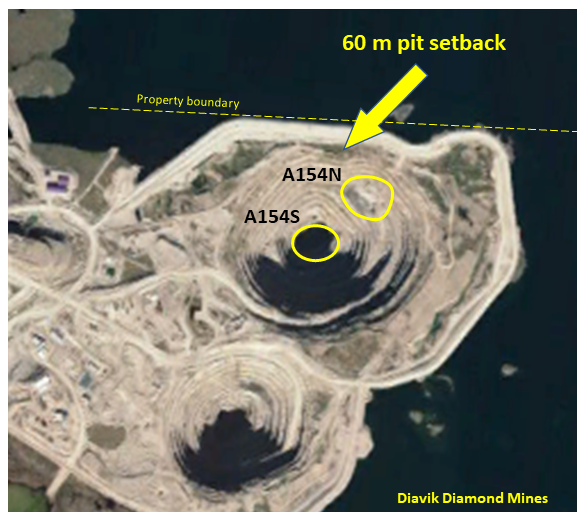
This is Part 2 of a blog post related to open pit mining within bodies of water. Part 1 can be found at this link “Mining Under Lakes – Part 1“, which provides a few examples where this has been done successfully. Part 2 focuses on some of the social and technical issues the need to be considered when faced with the challenge of open pit mining within a water body.
 The primary question to be answered is whether one can mine safely and economically without creating significant impacts on the environment.
The primary question to be answered is whether one can mine safely and economically without creating significant impacts on the environment.
The answer to this question will depend on the project location and the design of the water retaining structure.
I have worked on several projects where dike structures were built. I have also undertaken due diligence reviews of projects where dikes would be required. Most recently I have participated in some scoping level studies where mining within a lake or very close to a river were part of the plan.
In some instances, the entire orebody is located in the lakebed. In others, the orebody is mainly on land but extends out into the water. Each situation will be unique. In northern Canada, given the number of lakes present, it would be surprising if a new mining project isn’t close to a river or lake somewhere.
Dike concepts consider many factors
Different mining projects may use different styles of dikes, depending on their site conditions. Some dikes may incorporate sheet piling walls, slurry cutoff walls, low permeability fill cores, or soil grouting. There are multiple options available, and one must choose the one best suited for the site.
The following is list of some of the key factors and issues that should be examined.
ESG Issues
One’s primary focus should be on whether building a dike would be socially and environmentally acceptable. If it is not, then there is no point in undertaking detailed geotechnical site investigations and engineering design. One must have the “social license” to proceed down this path.
Water Body Importance: Is there a public use of the water body? It could be a fresh water source for consumption, used for agricultural or fishery purposes, or used as a navigable waterway, etc. Would the presence of the dike impact on any of these uses? Does the water body have any historical or traditional significance that would prevent mining within it?
 Lake Turbidity: Dike construction will need to be done through the water column. Works such as dredging or dumping rock fill will create sediment plumes that can extend far beyond the dike. Is the area particularly sensitive to such turbidity disturbances, is there water current flow to carry away sediments?
Lake Turbidity: Dike construction will need to be done through the water column. Works such as dredging or dumping rock fill will create sediment plumes that can extend far beyond the dike. Is the area particularly sensitive to such turbidity disturbances, is there water current flow to carry away sediments?
At Diavik, a floating sediment curtain surrounding the dike construction area was largely able to contain the sediment plume in the lake.
Regional Flow Regime: Will the dike be affecting the regional surface water flow patterns? If the dike is blocking a lake outflow point, can the natural flow regime be maintained during both wet and dry periods?
Location Issues
If there are no ESG issues preventing the use of a dike, the next item to address is the ideal location for it.
Water depth: normally as the dike moves further away from land, both the water depth and dike length will increase. The water depth at the deepest points along the dike are a concern due to the hydraulic head differential created once the interior water pool is pumped out. The seepage barrier must be able to withstand that pressure differential, without leaking or eroding. A low height dike in shallow water may be able to use a simpler seepage cutoff system than a dike in deep water.
Islands: Are there any islands located along the dike path that can be used to shorten the construction length and reduce the fill volumes? Is there a dike alignment path that can follow shallower water zones?
 Pit wall setback: Given the size and depth of the open pit, how far must the dike be from the pit crest? Its nice to have 200 metre setback distance, but that may push the dike out into deeper water.
Pit wall setback: Given the size and depth of the open pit, how far must the dike be from the pit crest? Its nice to have 200 metre setback distance, but that may push the dike out into deeper water.
If the dike is too close to the pit, then pit slope failures or stress relaxation may result in fracture opening and increase the risk of seepage flows or catastrophic flooding. The pit wall rock mass quality will be the key determining factor in the setback distance.
Maximizing ore recovery: If the ore zone extends further out into the lake, maximizing ore recovery may require using a steep pit wall along the outer sections of the pit. This may require positioning haulroads with switchbacks along other sides of the pit rather than using a conventional spiral ramp layout.
At Diavik (see image), the A154 north open pit wall was pushed to about 60 metres of the dike to access as much of the A154N kimberlite ore as possible. Haulroads were kept to the south side of the pit.
It may be possible to recover even more ore by pushing out the dike even further. However, this may result in a larger and costlier dike or even require a different style of dike. There will be a tradeoff between how much additional ore is recovered versus the additional cost to achieve that. There will be a happy medium between what makes both technical sense and economic sense.
Design Issues
 Once the approximate location of the dike has been identified, the next step is to examine the design of the dike itself. Most of the issues to be considered relate to the geotechnical site conditions.
Once the approximate location of the dike has been identified, the next step is to examine the design of the dike itself. Most of the issues to be considered relate to the geotechnical site conditions.
Lakebed foundation sediments: What does the lakebed consist of with respect to soft sediments? Soft sediments can cause dike settlement and cracking, or mud-waving of fill material.
Will the soft sediments need to be dredged prior to construction, and if so, where do you dispose of this dredge slurry, and what impact will dredging have on the lake turbidity?
Lakebed foundation gravels: Are there any foundation gravel layers that can act as seepage conduits beneath the dike? If so, will these need to be sub-excavated, or grouted, or cut off with some type of barrier wall? Sonic drilling, rather than core drilling, is a better way to identify the presence of open gravel beds.
Upper bedrock fracturing: Is the upper bedrock highly fractured, thereby creating leakage paths? If so, then rock grouting may be required all along the dike path to seal off these fractures.
Major faults: Are there any major faults or regional structures that could connect the open pit with the lake, acting as a source of large water inflow?. At Diavik, we attempted to characterize such structures with geotechnical drilling before construction. Upon review, I understand there was one such structure not identified, which did result in higher pit inflows until it was eventually grouted off.
Water level fluctuations: In a lake or river one may see seasonal water level fluctuations as well as storm event fluctuations. The height of the dike above the maximum water level (i.e. freeboard) must be considered when sizing the dike.
Ice scouring: In a lake or river that freezes over, ice loads can be an important consideration. During spring breakup as the ice melts, large sheets of ice can be pushed around and may scour or damage the crest of the dike. The dike must be robust enough to withstand these forces.
Construction materials available on site: Is there an abundance of competent rock for dike fill? Is there any low permeability glacial till or clay that can be used in dike construction? If these materials are available on site, the dike design may be able to incorporate them. If such materials are not available, then a alternate dike design may be more appropriate, albeit at a cost.
Conclusion


 Each mine site is different, and that is what makes mining into water bodies a unique challenge. However many mine operators have done this successfully using various approaches to tackle the challenge.
Each mine site is different, and that is what makes mining into water bodies a unique challenge. However many mine operators have done this successfully using various approaches to tackle the challenge.
Mining under bodies of water is briefly discussed in my chapter on Mining Method Selection in the new SME Underground Mining Handbook (Darling 2023)
Thanks Doug. As an example, I was alerted to the fact that Fission Uranium in western Sask likely has to mine parts of their orebody under a lake there. They are at the feasibility stage right now.
Although still in discovery stage PMETs corvette has tackled this issue amongst investor addressing it early throughout presentations. Using the project you worked on diavik as the primary example.